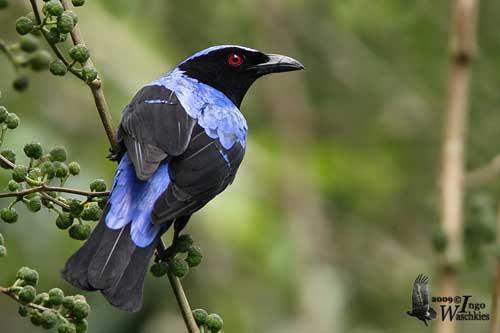
Fr: Irène vierge
All : Türkisirene
Esp: Ave Flor de Espalda Negra
Ital: Irena dorsoazzurro
Nd: Indische Blauwrug
Sd: Indisk Blåfågel
Photographer:
Ingo Waschkies
My bird pictures on Pbase
Text by Nicole Bouglouan
Sources:
HANDBOOK OF THE BIRDS OF THE WORLD Vol 10 by Josep del Hoyo-Andrew Elliott-David Christie - Lynx Edicions - ISBN: 8487334725
L’ENCYCLOPEDIE MONDIALE DES OISEAUX - Dr Christopher M. Perrins - BORDAS - ISBN: 2040185607
BirdLife International (BirdLife International)
CREAGUS@Monterey Bay (Don Roberson)
Wikipedia, the free encyclopaedia
Asian Fairy-bluebird
Irena puella
Passeriforme Order – Irenidae Family
BIOMETRICS:
Length: 21-26 cm
Weight: M: 56-75 g – F: 52-71 g
DESCRIPTION:
The Asian Fairy-bluebird is an arboreal species, always active amongst the vegetation. The plumage may appear fairly dull in the shade, but when the sun lights up the male’s back, the sapphire-blue feathers are very conspicuous.
The adult male has blue and black plumage.
On the upperparts, central crown and nape, back, rump, uppertail-coverts and narrow wing-bar are brilliant blue. Flight feathers and rectrices are black.
The underparts are black, except the undertail-coverts which are brilliant blue.
On the head, forehead, face, head and neck sides and chin are black. Central crown and nape are brilliant blue.
The strong bill is black. The eyes are bright red. Legs and feet are black.

The adult female has duller appearance. She has malachite-green head, body, upperwing-coverts, tertials and central tail feathers. On rump, uppertail-coverts and underparts, the feathers show slightly bluer edges. Rest of plumage is sooty brown. The flight feathers have verditer-green edges and outer tail feathers have malachite outer webs. The female has paler eyes, mostly orange-red.
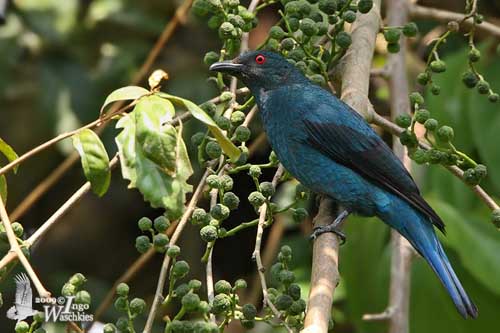
The juvenile resembles female but with brown wings and eyes.
The immature is similar to female. The young male is slightly bluer but the eyes are darker brown than in juvenile.
We can find six subspecies which differ in blue colour tone of male and uppertail-coverts’ shape and length.
VOICE: SOUNDS BY XENO-CANTO
The Asian Fairy-bluebird’s contact calls are liquid, strident and carrying whistles “weet weet” or “tui-wit-weet” and several variations.
During the courtship displays, the male utters “wii-dip-wii-dip-dip wii-dip…” and also whistles similar to those of Common Starling.
The pair members give hoarse “chrroachch” at close quarters.
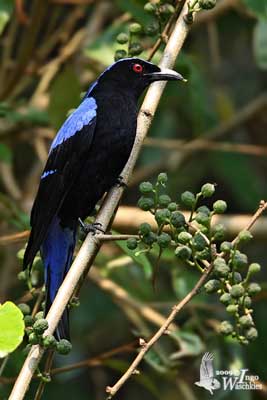
HABITAT:
The Asian Fairy-bluebird frequents forest from lowlands up to 1800 metres of elevation in India, and 1900 metres in Malay Peninsula, but it is usually seen lower, between 850 and 1200 metres.
This forest species may emerge from its usual habitat into tea and coffee plantations with scattered trees, probably attracted by flowering and fruiting trees.
RANGE:
The Asian Fairy-bluebird is found across tropical southern Asia, from Himalaya foothills, India and Sri Lanka, Indochina, Greater Sundas and Philippines.
BEHAVIOUR:
The Asian Fairy-bluebird feeds mainly on fruits, from berries to figs from Ficus, and nectar from flowers in some parts of the range. Some insects such as alate termites are also taken in the air.
It takes the fruit while perched on the branch in tree or bush, but also while flying. It forages at mid-level and canopy in the forest. It rarely descends to the ground.
It also joins mixed-feeding groups hunting among the foliage. They can raid coffee berries in plantations.
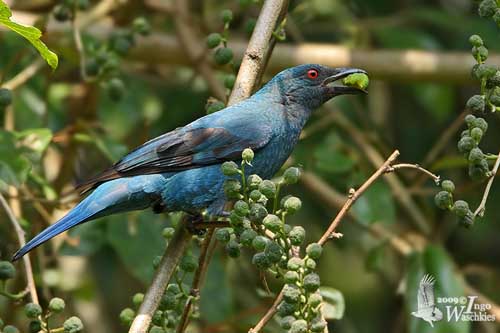
The breeding behaviour is poorly known, but some reports from captive birds talk about mutual preening between mates and calls in unison.
During the displays, the male raises the scapulars in order to enhance the glossy blue upperparts. It also performs vibrations of body and tail, side-to-side movements, neck-stretching and head-jerking with fluffed-out crown feathers and open bill. These displays are accompanied by song, while the red of the eyes becomes brighter. Some chases are also reported.
The Asian Fairy-bluebird is mainly resident in its range. Some local movements are reported, probably according to the seasonal flowering and fruiting events.
FLIGHT:
The Asian Fairy-bluebird is always very active. It performs powerful, direct flight through and above the canopy.
REPRODUCTION:
The breeding season varies according to the range.
The Asian Fairy-bluebird’s nest is placed on fork or palm frond, between 2 and 6 metres above the ground in the understorey or the lower mid-level of forest. The nest is built by the female. This is a small flimsy cup made with twigs and green bryophytes.
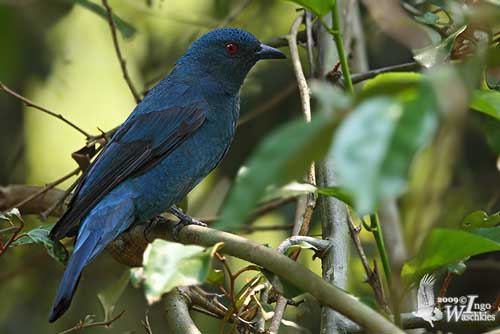
The female usually lays 2 eggs and incubates during about two weeks. The chicks are raised by one or both parents, and fledge about 13 days after hatching. They are fed mainly with insects.

DIET:
The Asian Fairy-bluebird feeds mainly on fruits, from small berries to figs from Ficus. It may seasonally take nectar from flowers in some parts of the range.
It also catches termites in the air.
PROTECTION / THREATS / STATUS:
The Asian Fairy-bluebird can be relatively common according to the range, but also locally rare.
This species is threatened by habitat loss and increase of hunting pressure.
Some subspecies such as “turcosa” in Java, “crinigera” in Sumatra and “tweeddalei” in W Philippines are probably already Near Threatened or Vulnerable. The removal of large canopy-cropping fig trees has high impact on frugivores species.
However, the species is currently evaluated as Least Concern by Birdlife International.